
Today, patients can have a level of sedation dentistry for regular teeth cleanings to tooth extractions. As a sedation dentist, we pay close attention to the procedure and give the patient advice on the level of sedation the patient needs to get through the procedure. Since we do not want the patient to go to sleep unnecessarily, we will ensure we only give the necessary to calm the patient for the procedure. In some cases, complete unconsciousness may be necessary. In most regular maintenance cases, we simply need to help the patient relax. Since the patient can also choose what level of sedation he or she is comfortable with, below are the four levels that we typically use as a sedation dentist.
General anesthesia
General anesthesia is the most impactful of the sedation methods in which the patient is completely unconscious. We do not prefer this method unless it is a serious procedure. With the more intensive procedures, we will require someone to take the patient home since the patient will need more time for the anesthesia to wear off.
Deep sedation
Unlike with general anesthesia, deep sedation has the individual fall asleep. Typically this is a very light sleep, which holds patients on the edge of consciousness. If need be, the sedation dentist can easily wake the patient up from this kind of sleep.
Moderate sedation
Moderate sedation is the first level of sedation where we truly sedate the patient but have the patient stay awake. The patient will feel the effects of the sedation and may not remember much of the procedure despite being awake.
Minimal sedation
This is used for many minor procedures because you are completely awake and aware, but the sedation makes you completely relaxed and able to let go of all your anxiety.


